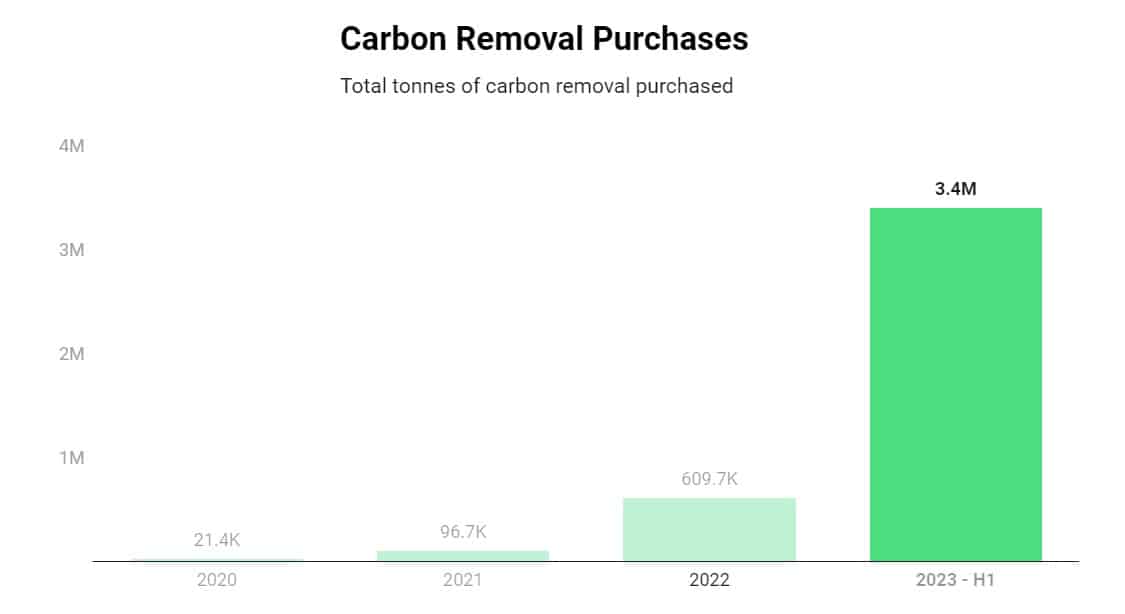Isometric, a fascinating carbon removals startup, launched its new Isometric Standard that outlines the most stringent set of rules for carbon removals.
The London and New York-based company is building the world’s first independent and transparent registry for durable carbon removal credits. They have pioneered a new, innovative approach that tackles the issues confronting the traditional carbon offset market.
Isometric: Scientific Platform and Registry for CDR
Founded in 2022, Isometric aims to provide the technology necessary to scale up the nascent carbon dioxide removal (CDR) industry. They report data and verification results from a vast network of partners on their science platform and public registry.
The goal is to bring more confidence in the market and propel buyers to make even bigger purchases. This year’s first half reported purchases show that the industry is poised for growth.

While Isometric seeks CDR to scale fast, it ensures that the growth is responsible. The company is a team of experts building two products to ensure such growth.
First is the Science Platform: built to help carbon removals scale fast. Here, the scientific experts work together to accelerate alignment with high quality standards.
The platform enables CDR suppliers to host and visualize their removal data and protocols clearly and consistently.
Second is Isometric’s Registry: created to ensure CDR scales responsibly. It allows Isometric to publish verified carbon removal records scientifically, transparently, and in collaboration with the right experts.
The company believes that the CDR industry, though it currently removes only a few kilo tons of CO2, will grow at a pace and rate needed to remove gigatonnes of CO2 each year.
- RELATED: Scaling the Carbon Removal Industry
Carbon removals have significant tailwinds. Last year, the Energy Department had pledged $3.7 billion to build the CDR industry in the U.S. Likewise, the UK has plans to amend its Emissions Trading Scheme to welcome engineered or technological carbon removals.
The CDR can be a huge part of the next $1 trillion industry, but with the right rules. This is what the Isometric Standard aims to achieve – providing the right framework for carbon removal credits.
What is The Isometric Standard?
Remarking on the launch of the Standard, Eamon Jubbawy, CEO & Founder of Isometric, said that they’re raising the bar for carbon credits. He further noted that:
“Rebuilding trust in the Voluntary Carbon Market requires both rigorous science and transparency…The Isometric Standard represents an opportunity for the carbon removal industry to rise to meet the urgent challenges we face.”
The Isometric Standard recognizes only carbon credits that can prove that they actually have removed CO2 from the atmosphere. The captured CO2 must also be stored permanently and quantifiable through long-duration timelines, mostly for >1,000 years.
The Standard doesn’t include “avoidance” carbon credits. This type of carbon credit is associated with nature-based climate solutions such as reforestation.
Isometric Standard also does not deal with carbon credits generated by projects that run the risk of temporary CO2 storage. For example, tree-planting initiatives face this risk because of wildfires.
Moreover, the Standard is a product of a collaboration among over 150 expert scientists that follows a trusted approach. The public can investigate fully the calculations behind each carbon removal credit listed on Isometric’s platform.
In other words, the Standard builds on trust and transparency in generating carbon credits.
- RELATED: Forging Trust for Carbon Removal
Fostering Climate Action With Durable CDR
With scientific rigour and radical transparency, the Isometric Standard offers an opportunity for the fast-growing carbon removal industry to prevent issues plaguing the market, particularly greenwashing.
The Standard guides Isometric Crediting Program in two unique ways. First, it provides guidance and transparent infrastructure fostering high quality climate action in the form of durable removals of CO₂. Second, it issues verified credits as proof of the ownership of removal claims and reporting purposes.
It also lists all the requirements which ensure that delivered tonnes have measurable and verifiable climate impact. It also sets out the duties and obligations of stakeholders in relation to the Isometric Registry.
The credited tonnes of removal must be durable, additional, and measured using the latest scientific methods. All the requirements and rules for crediting are laid out in the Standard, including issuance, retirement, reversals, and buffer pools.
Offering the foundation of trust in CDR credits, the industry can grow to the scale the world needs to stay within the 1.5C warming threshold. When the stakes are high, the standards need to match.
By focusing on transparency, permanence, and rigorous science, Isometric Standard provides a framework that can help the carbon removal industry flourish while ensuring that carbon credits genuinely contribute to a greener future.


